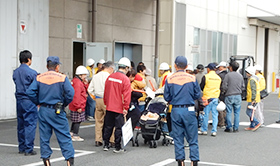Water and effluents / Emission /
Waste /
Safety and disaster readiness
Material Issue Water and effluents
- Targets/Vision
- ● Manage total water withdrawal per water source by actual value
- ● Comply with our voluntary standard for quality of water discharge and reduce water withdrawal at each production base
Management and Promotion Method of Water and effluents
[Responsible Departments]
- Manufacturing Planning Center
- Business divisions
Coordinating office: Company-wide Environment Committee (Secretariat: Environmental Promotion Department of Manufacturing Planning Center)
[Policy/Point of view]
The Group sets forth the preservation of the global environment in the “Group Code of Conduct” and the
“Environmental Basic Policy” and strives to save resources and energy and reduce wastes and hazardous
substances in each stage of technology development, design, procurement, production, sale, and use of
products and services. We recognize the importance of water resource that is essential for our
production activities and launched initiatives to confirm and reduce water risk.
As for the volume of water consumption, each business manages the total water withdrawal by source.
As for effluents, each business facility checks the volume and quality of water discharge to comply with the standards set by relevant local governments.
[Targets/Vision]
- Manage the total water withdrawal per water source by actual value
- Maintain the quality of water discharge below the standards set by local governments
- Comply with our voluntary standard for quality of discharged water and reduce water withdrawal at our production bases
[Measures]
- Manage the total water withdrawal per water source at each business facility
- Check the volume and quality of water discharge at each business facility
Launched an initiative to understand and reduce water risk
Although none of the Group’s production bases is currently located in areas with water restriction, we recognize the importance of water resources that is essential for our production activities and launched an initiative to understand and reduce water risk in fiscal 2018.
In fiscal 2024, we continued to conduct regular water quality monitoring and manage water withdrawal and discharge volumes at our production bases. We will continue our efforts to further reduce water risk and conserve water resources.
●Total water withdrawal and discharge (Fiscal 2022 to 2024)
| (FY) | Bando Chemical Industries | Domestic consolidated production subsidiaries | Overseas consolidated production subsidiaries | Bando Chemical Industries and consolidated production subsidiaries | |
|---|---|---|---|---|---|
| Total water withdrawal (m3/year) |
2022 | 611,497 | 5,509 | 430,100 | 1,047,106 |
| 2023 | 685,214 | 5,316 | 427,110 | 1,117,640 | |
| 2024 | 670,573 | 5,054 | 466,655 | 1,142,283 | |
| Total water discharge (m3/year) |
2022 | 171,456 | 1,102 | 87,916 | 260,474 |
| 2023 | 183,892 | 1,063 | 84,939 | 269,895 | |
| 2024 | 188,376 | 1,477 | 103,694 | 293,547 |
Compliance with our voluntary standard for quality of discharged water
The quality of water discharge of production base is managed using the voluntary standard set stricter than those set by relevant local governments.
The Group’s production bases have in place a system to stop discharging water and collect it when abnormality is found in water quality in daily operations, but recently, heavy rains that cause massive damages are becoming more frequent, raising the risk of leakage or effluence of contaminants, wastes, and liquid raw materials.
Nankai Plant upgraded its oil water separators to higher-performance equipment, installed oil film detectors in drains and cooling water collection tanks and continues to measure the volume supplied to neighboring farmers whose waste discharge had not been measured.
Ashikaga Plant installed water quality monitoring equipment as water used in its production process and cafeteria, etc. is discharged into rivers via a purifying chamber and continues to monitor the water quality.
Ashikaga Plant and North Kanto Processing Center of Bando Industrial Components & Services, Ltd. replaced the aging purifying chambers with high-efficiency ones.
Kakogawa Plant raised the oil weir of oil-water separation paths.
Wakayama Plant continues to implement measures to prevent rainwater ingress into and waste oil leaks at the industrial waste storage, compiled a manual on how to collect water withdrawal data by water source, and continues to monitor water withdrawal.
Material Issue Emission
- Targets/Vision
● Bando Chemical Industries’ target for fiscal 2030: 33,915t-CO2t (reduction by 38% from the fiscal 2013 level) Bando Group target for fiscal 2050: Carbon Neutrality
Management and Promotion Method of Emission
[Responsible Departments]
- Manufacturing Planning Center
- Business divisions
Coordinating office: Company-wide Environment Committee (Secretariat: Environmental Promotion Department of Manufacturing Planning Center)
[Policy/Point of view]
The Group sets forth the preservation of the global environment in the “Group Code of Conduct” and the
“Environmental Basic Policy” and strives to save resources and energy and reduce wastes and hazardous
substances in each stage of technology development, design, procurement, production, sale, and use of
products and services.
Recognizing the seriousness of the escalation of climate change issues, the Company aims at reducing
CO2 emissions which is one of the aggravating factors for climate change risks, and has implemented
various initiatives such as shifting to different fuels, switching to high-efficiency equipment and
LED lighting, and installing high-efficiency boilers at business facilities, in addition to
aggressively adopting modal shifts, joint deliveries, and milk run logistics. We are also proactively
adopting new methods such as ESCO service and Joint Crediting Mechanism.
The Company has set a long-term target for the reduction of CO2 emissions, with the actual results
managed by each business facility.
[Target]
| Bando Chemical Industries’ target for fiscal 2030: 33,915t-CO2t (reduction by 38% from the fiscal 2013 level) | |
| Bando Group target for fiscal 2050: | Carbon Neutrality |
[Measures]
- 1. Shift to energy-saving equipment
- 2. Reduce energy loss (investigate details of loss due to steam leak, implement necessary measures, etc.)
- 3. Achieve 100% of tasks set out in the roadmap toward CO2 emission reduction
Initiatives for CO2 emission reduction
To achieve “fiscal 2030 target” to reduce CO2 emissions by 38% by fiscal 2030 compared to the fiscal 2013 level (54,703t-CO2), we have shifted to different fuels, upgraded to high-efficiency boilers, introduced LED lighting, and upgraded to high-efficiency equipment, as well as actively introduced the Joint Crediting Mechanism.
In fiscal 2024, we focused on the reduction of energy loss as one of the material issues with respect to SCOPE 1, resulting in a 12.3% year-on-year decrease in CO2 emissions, and worked to reduce electricity consumption for SCOPE 2. Meanwhile, external factors such as the increase in the CO2 emission factor of purchased electricity raised concerns about a potential rise in emissions, prompting us to partially purchase renewable energy certificates. As a result of these efforts, total CO2 emissions in fiscal 2024 decreased 18.4% year-on-year to 39,739t-CO2.
* Please see “MAKING A POSITIVE IMPACT” on pages 28 to 29 for our efforts to capture climate-related opportunities and the created impact.
CO2 emissions (t) (Bando Chemical Industries)
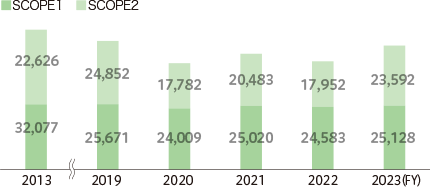
Scope 1: Direct emissions by the Company from use of fuel, etc.
Scope 2:Indirect emissions from power stations, etc. associated with the consumption of electricity purchased by the Company
*For the figures before fiscal 2019, the emission factor is changed from fixed value to actual value from fiscal 2020.
*We have obtained third-party assurance for GHG emissions (Scope 1 and 2: consolidated data) for fiscal 2024 from SOCOTEC Certification Japan.
Environmental impact in value chain
From the perspective of global environmental conservation, we have worked to improve the accuracy of calculation of emissions from the entire value chain from procurement of raw materials to disposals (Scope 3), in addition to GHG emissions from our business activities (Scope 1 and 2), and are disclosing the figures.
Scope 3 emissions by category
| Category | Scope | Emissions in fiscal 2024 (t) | |
|---|---|---|---|
| 1 | Goods and services purchased | Non-consolidated | 50,406 |
| 2 | Capital goods | Consolidated | 19,126 |
| 3 | Fuel and energy related activities not included in Scope 1 and 2 | Non-consolidated | 3,882 |
| 4 | Transport and delivery (upstream) | Non-consolidated | 1,436 |
| 5 | Wastes generated from business activities | Non-consolidated | 2,310 |
| 6 | Business trips | Non-consolidated | 867 |
| 7 | Employee commuting | Non-consolidated | 387 |
| 8 | Leased assets (upstream) | N.A. | |
| 9 | Transport and delivery (downstream) | Non-consolidated | - |
| 10 | Processing of products sold | Non-consolidated | 98 |
| 11 | Use of products sold | Not included in the calculation due to no direct emissions during use | |
| 12 | Disposal of products sold | Consolidated | 507 |
Reduction of VOC emissions
Volatile organic compounds (VOC) are considered as major causal substances of photochemical oxidants and are subject to the voluntary reduction effort under the Clean Air Act.
We work to reduce VOC emissions by installing the VOC processing equipment and ensuring proper handling and storage of the compounds. We set our voluntary reduction target at 55% reduction from the fiscal 2000 level, which is higher than the industry target of 50%, and have been successfully reducing emissions at levels exceeding the target.
In fiscal 2024, we continued to implement measures and achieved a 72.8% reduction compared with the fiscal 2000 level, achieving the reduction target.
VOC emissions (t) (Bando Chemical Industries)
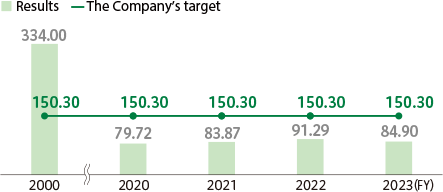
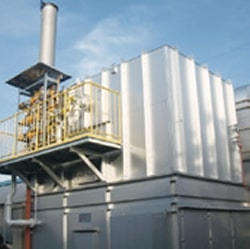
VOC processing equipment
Initiatives to reduce environmental impact in logistics
We are working on improving transport efficiency and lightening packing in order to reduce environmental impact arising from material procurement and product shipment as well as transportation of intermediate products between production bases. We are also promoting such initiatives as joint deliveries, milk run logistics, and modal shifts with an aim to reduce CO2 and NOx emissions generated by freight transport.
Material Issue Waste
- Targets/Vision
- ● Achieve zero emissions
- ● Waste plastic: 1% reduction from the previous fiscal year (total volume)
Management and Promotion Method of Waste
[Responsible Departments]
- Manufacturing Planning Center
- Business divisions
Coordinating office: Company-wide Environment Committee (Secretariat: Environmental Promotion Department of Manufacturing Planning Center)
[Policy/Point of view]
The Group sets forth the preservation of the global environment in the “Group Code of Conduct” and the
“Environmental Basic Policy” and strives to save resources and energy and reduce wastes and hazardous
substances in each stage of technology development, design, procurement, production, sale, and use of
products and services.
For waste, each business facility checks the waste generation to comply with the standards set by relevant local governments.
[Visions]
- Achieve zero emissions
- Waste plastic: 1% reduction from the results of the previous fiscal year (total volume)
- Compliance with the Plastic Resource Circulation Act
[Measures]
- Determine priority issues based on the waste analysis (reduction of loss and defective products) and promote initiatives on the recycling issues
- Expand research on measures for recycling waste plastic
Achieve zero emissions
We have already achieved zero emissions* through thorough waste separation. We will continue to work on reducing waste generation for the efficient use of resources.
*Definition of zero emissions: Final landfill disposal rate of less than 1% (final landfill disposal rate = final landfill disposal volume/volume of waste generation)
Recycling rate (Bando Chemical Industries)
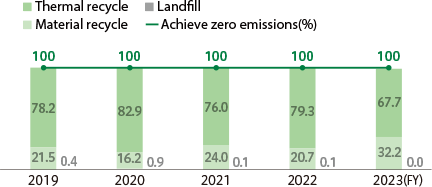
Compliance with the Plastic Resource Circulation Act
The Plastic Resource Circulation Act came into effect in April 2022. In fiscal 2024, we continued our efforts to reduce waste plastic by 1% year-on-year by reinforcing the segregation of reusable materials from waste to promote their conversion into valuable resources. As a result, the volume of industrial plastic waste in fiscal 2024 decreased by 14% year-on-year from 956 tons to 818 tons, achieving the target. In fiscal 2025, we will continue and further expand our efforts to convert reusable materials into variable resources.
Emissions and transfer volumes of PRTR substances
We designated substances specified in the Pollutant Release and Transfer Register (PRTR) system* as controlled substances and adequately manage PRTR substances in accordance with the Act on the Assessment of Releases of Specified Chemical Substances in the Environment and the Promotion of Management Improvement.
*Pollutant Release and Transfer Register (PRTR) system: A system whereby business operators are required to identify the amount of chemical substances potentially hazardous to human health and ecosystems emitted from the plants into the environment (air, water, and soil) and the amount transferred out of the plants as part of the wastes and report them to the government, which then aggregates and publishes the emitted/transferred amounts based on the submitted data and estimates.
Emissions and transfer volumes of PRTR substances (t) (Bando Chemical Industries)
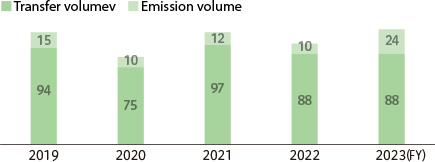
Material Issue Safety and disaster readiness
- Targets/Vision
- ● Fires: None
- ● Create disaster-resistant working places
Compliance with environmental laws and regulations
[Responsible Departments]
- Each business facility
Coordinating office: Company-Wide Health and Safety Committee (Secretariat: Safety and Quality Control Department of Manufacturing Planning Center)
[Policy/Point of view]
- Since fires can significantly impact not only employees but also business activities, we are committed to promoting fire prevention and recurrence prevention activities to ensure the safety of our employees and contribute to the continuity of our business.
[Targets/Vision]
- Fire: None
[Measures]
- The progress in fire prevention measures is regularly monitored by the Company-Wide Health and Safety Committee and the Safety and Health Committee at each business facility, with ongoing efforts made to drive continuous improvement.
1. Implement fire prevention education
2. Conduct fire prevention patrols, etc.
[Responsible Departments]
- Each business facility
Coordinating office: Company-Wide Health and Safety Committee and Company-Wide Environment Committee
[Policy/Point of view]
- As the Company is engaged in manufacturing while interacting with society and local communities, we established the “Group Code of Conduct” and the “Health and Safety Policy” to set forth the compliance with the environmental laws and regulations and agreements with the local governments and industries, and are striving to prevent pollution in society and local communities with the target of achieving “No claims, accidents or emergencies.”
[Targets/Vision]
- Creating disaster-resistant working places
[Measures]
- Maintain the latest version of the environmental laws and regulations and agreements with local communities that are applicable to business facilities in accordance with the “Environmental Guidelines” Evaluate each business facility’s status of compliance with the applicable environmental laws and regulations, etc. in accordance with the compliance assessment of the “Environmental Manual” Provide education to employees using textbooks incorporating past incidents Participate in security and disaster readiness activities in local communities/Hold meetings for local residents near business facilities
Promotion of fire prevention and recurrence prevention activities
The Group is engaged in manufacturing while interacting with society and community and aims at “No fires” by enhancing initiatives to prevent them. In fiscal 2024, three accidents (three fires) occurred.
The analysis of the causes revealed (1) missed incident reporting, (2) incorrect configuration of temperature anomaly detection systems, and (3) inadequate isolation of ignition sources from combustible materials, and therefore we implemented measures. In fiscal 2025, we will continue our preventive activities and aim at “No fires.”
Security and disaster readiness activities
We also focus on security and disaster readiness activities in preparation for emergencies to ensure business continuity and safe operation. Specifically, the Bando Group suffered massive damages to its Head Office and production bases from the Great Hanshin-Awaji Earthquake, and therefore we continue to work on creating disaster-resistant working places.
-
Earthquake countermeasures and emergency drills, etc.
In addition to antiseismic reinforcement of the buildings at domestic offices, we conduct the Shakeout drills (actions to protect oneself from earthquakes) using the sound of the earthquake early warning. We are also promoting disaster prevention measures including conducting joint drills with local fire stations or brigades or in-house fire drills at each site of the Group as well as conducting safety confirmation drills assuming a disaster scenario and preparing stockpiles at domestic group companies.
